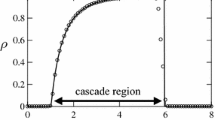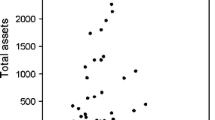Abstract
This article investigates the behaviour of the European banking system during the financial crises that occurred in the last decades. Among the various approaches for measuring systemic risk, we consider network analysis, which describes the linkages among financial institutions and their whole structure. We construct a time-varying network of the European banking system. Banks are linked to form a global interconnected system and they mutually influence one another in terms of risk. We model their reciprocal influence via a weighted and directed network, in which weights are related to risk measures that are based on equity returns. Then, we apply two network indicators to investigate the prominence of a bank in spreading and receiving risk from the others. The results enable us to capture many features of the banking system while identifying the global systemically important banks. Moreover, the results of the analysis over time show how interconnections change over periods that are characterized by various economic scenarios.




Similar content being viewed by others
Notes
For example, European Central Bank (2009) defines systemic risk as the “risk that financial instability becomes so widespread that it impairs the functioning of a financial system to the point where economic growth and welfare suffer materially”. Benoit et al. (2017) refer to the “risk that many market participants are simultaneously affected by severe losses, which then spread through the system”.
We refer to the 2014 exercise since the sample is wider compared to the more recent exercises; our objective is to approximate the whole European banking system, including banks that differ in terms of size and features.
The equity returns have been collected from FactSet financial data and analytics (www.factset.com).
Density exceeds 0.99 in “2-2007” and “1-2008” and is equal to 1 at the end of 2008.
This point will become more evident later via analysis of Fig. 2.
See European Union Referendum Act, December 2015.
For instance, between windows “2-2008” and “1-2009”, the 99th quantile of the MES distribution moves from 11% to approximately 14%, while the 99th quantile of the ES distribution varies from 19 to 25%.
A smaller increase is observed for Permanent, for which the ES moves from 22 to 27%.
As expected, the Brexit effect spreads over the whole banking system. For example, Raddant (2016) analyses the impact of Brexit on stock market prices and volatility in various sectors; all sectors in UK, Germany, France Spain and Italy react to the Brexit vote and the most pronounced effect is observable for the financial sector. Recently, Candelon et al. (2018) analysed the impact of Brexit on the European equity market by adopting a network approach that is based on a threshold vector autoregressive model and observed an increase in the degree of interconnectedness that was due to the Brexit event.
The peak in 2008 of the network indicators is a common feature of networks that are based on equity returns. Similar results are observed for example, in Billio et al. (2012) and in Kenett et al. (2012); however, these works focus on mean correlations instead of tail dependence, which is the main driver of systemic risk.
These data are available for large European banks on the EBA website.
According to Benoit et al. (2018), the score of Nordea was lower than the cut-off value for being classified as a G-SIB in 2016. This bank was added to the list by regulatory judgement.
Interconnections in the Basel score are quantified by intra-financial system assets and liabilities and securities outstanding, which are influenced by size.
Related to this, Raddant (2016) shows that the Italian financial sector reacted more strongly to the Brexit vote compared to other European countries.
The correlations with MES and DeltaCoVaR are insignificant, while the correlations with SRISK and DollarDeltaCoVaR (which account for size) are significant but not sufficiently strong to suggest overlapping information.
References
Acharya VV, Pedersen LH, Philippon T, Richardson M (2017) Measuring systemic risk. Rev Financ Stud 30:2–47
Adrian T, Brunnermeier MK (2016) CoVar. Am Econ Rev 106(7):1705–1741
Allen F, Gale D (2000) Financial contagion. J Polit Econ 108(1):1–33
Babus A (2016) The formation of financial networks. RAND J Econ 47(2):239–272
Bardoscia M, Battiston S, Caccioli F, Caldarelli G (2015) DebtRank: a microscopic foundation for shock propagation. PloS ONE 10(6):e0130406
Bardoscia M, Caccioli F, Perotti JI, Vivaldo G, Caldarelli G (2016) Distress propagation in complex networks: the case of non-linear debtrank. PloS ONE 11(10):e0163825
Bardoscia M, Battiston S, Caccioli F, Caldarelli G (2017) Pathways towards instability in financial networks. Nat Commun 8:14416
Bargigli L, Tedeschi G (2014) Interaction in agent-based economics: a survey on the network approach. Phys A Stat Mech Appl 399:1–15
Basel Committee on Banking Supervision (2011) Basel III: A global regulatory framework for more resilient banks and banking systems. Technical report
Basel Committee on Banking Supervision (2014) The G-SIB assessment methodology. Score calculation, Technical report
Basel Committee on Banking Supervision (2017) Finalising post-crisis reforms. Technical report
Basel Committee on Banking Supervision (2018) Global systemically important banks: revised assessment methodology and the higher loss absorbency requirement. Technical report
Battiston S, Puliga M, Kaushik R, Tasca P, Caldarelli G (2012) DebtRank: Too central to fail? Financial networks, the fed and systemic risk. Sci Rep 2:srep00541
Battiston S, Caldarelli G, D’Errico M, Gurciullo S (2016) Leveraging the network: a stress-test framework based on DebtRank. Stat Risk Model 33(3–4):117–138
Benoit S, Colliard JE, Hurlin C, Prignon C (2017) Where the risks lie: a survey on systemic risk. Rev Finance 21(1):109–152. https://doi.org/10.1093/rof/rfw026
Benoit S, Hurlin C, Perignon C (2018) Pitfalls in systemic-risk scoring. J Financ Intermed
Billio M, Getmansky M, Lo AW, Pelizzon L (2012) Econometric measures of connectedness and systemic risk in the finance and insurance sectors. J Financ Econ 104(3):535–559
Bisias D, Flood M, Lo AW, Valavanis S (2012) A survey of systemic risk analytics. Annu Rev Financ Econ 4(1):255–296
Bongini P, Clemente GP, Grassi R (2018) Interconnectedness, G-SIBs and network dynamics of global banking. Finance Res Lett 27:185–192
Bosma JJ, Koetter M, Wedow M (2019) Too connected to fail? Inferring network ties from price co-movements. J Bus Econ Stat 37(1):67–80
Caccioli F, Barucca P, Kobayashi T (2018) Network models of financial systemic risk: a review. J Comput Soc Sci 1(1):81–114
Candelon B, Ferrara L, Joëts M (2018) Global financial interconnectedness: a non-linear assessment of the uncertainty channel. Technical report WP n. 661, Banque de France. https://publications.banque-france.fr/en/global-financial-interconnectedness-non-linear-assessment-uncertainty-channel
Clemente GP, Grassi R (2018) Directed clustering in weighted networks: a new perspective. Chaos Solitons Fractals 107:26–38
Constantin A, Peltonen TA, Sarlin P (2016) Network linkages to predict bank distress. J Financ Stab 35:226–241
Das SR (2016) Matrix metrics: network-based systemic risk scoring. J Altern Invest 18(4):33–51
De Bandt O, Héam JC, Labonne C, Tavolaro S et al (2013) Measuring systemic risk in a post-crisis world. Technical report, Banque de France
Delli Gatti D, Gallegati M, Greenwald B, Russo A, Stiglitz JE (2010) The financial accelerator in an evolving credit network. J Econ Dyn Control 34(9):1627–1650
European Central Bank (2009) The concept of systemic risk. Financial Stability Review, pp 134–142
Fagiolo G (2007) Clustering in complex directed networks. Phys Rev E 76(2):026107. https://doi.org/10.1103/physreve.76.026107
Giudici P, Spelta A (2016) Graphical network models for international financial flows. J Bus Econ Stat 34(1):128–138
Grilli R, Tedeschi G, Gallegati M (2015) Markets connectivity and financial contagion. J Econ Interact Coord 10(2):287–304
Hakkio CS, Keeton WR (2009) Financial stress: What is it, How can it be measured, and Why does it matter? Econ Rev (Q II): 5–50
Hashem SQ, Giudici P (2016) Netmes: a network based marginal expected shortfall measure. J Netw Theory Finance 2(3):1–36
Hautsch N, Schaumburg J, Schienle M (2015) Financial network systemic risk contributions. Rev Finance 19(2):685–738
Holló D, Kremer M, Lo Duca M (2012) CISS—a composite indicator of systemic stress in the financial system. European Central Bank Working Paper
Horn RA, Johnson CR (2012) Matrix analysis, 2nd edn. Cambridge University Press, New York
Illing M, Liu Y (2006) Measuring financial stress in a developed country: an application to canada. J Financ Stab 2(3):243–265
Kenett DY, Tumminello M, Madi A, Gur-Gershgoren G, Mantegna RN, Ben-Jacob E (2010) Dominating clasp of the financial sector revealed by partial correlation analysis of the stock market. PloS ONE 5(12):e15032
Kenett DY, Preis T, Gur-Gershgoren G, Ben-Jacob E (2012) Dependency network and node influence: Application to the study of financial markets. Int J Bifurc Chaos 22(07):1250181
Kleinberg JM (1999) Authoritative sources in a hyperlinked environment. J ACM (JACM) 46(5):604–632
Lenzu S, Tedeschi G (2012) Systemic risk on different interbank network topologies. Phys A Stat Mech Appl 391(18):4331–4341
Leon CL, Pérez J (2014) Assessing financial market infrastructures’ systemic importance with authority and hub centrality. J Financ Mark Infrastruct 2(3):66–87
Lo Duca M, Koban A, Basten M, Bengtsson E, Klaus B, Kusmierczyk P, Lang JH, Detken C, Peltonen T et al (2017) A new database for financial crises in European countries. Technical report, European Central Bank
Minoiu C, Reyes J (2013) A network analysis of global banking: 1978–2010. J Financ Stab 9(2):168–184. https://doi.org/10.1209/0295-5075/115/18002
Neveu AR (2018) A survey of network-based analysis and systemic risk measurement. J Econ Interact Coord 13(2):241–281. https://doi.org/10.1007/s11403-016-0182-z
Poledna S, Thurner S (2016) Elimination of systemic risk in financial networks by means of a systemic risk transaction tax. Quant Finance 16(10):1599–1613
Poledna S, Martínez-Jaramillo S, Caccioli F, Thurner S (2018) Quantification of systemic risk from overlapping portfolios in the financial system. arXiv preprint arXiv:180200311
Raddant M (2016) The response of european stock markets to the Brexit. Technical report, Kiel Institute for the World Economy (IfW)
Rotundo G, Ausloos M (2010) Organization of networks with tagged nodes and biased links: a priori distinct communities: the case of intelligent design proponents and Darwinian evolution defenders. Phys A Stat Mech Appl 389(23):5479–5494
Sonubi A, Arcagni A, Stefani S, Ausloos M (2016) Effects of competition and cooperation interaction between agents on networks in the presence of a market capacity. Phys Rev E 94(2):022303
Tabak B, Takamib M, Rochac J, Cajueirod D, Souzae S (2014) Directed clustering coefficient as a measure of systemic risk in complex banking networks. Phys A Stat Mech Appl 394:211–216. https://doi.org/10.1016/j.physa.2013.09.010
Tedeschi G, Mazloumian A, Gallegati M, Helbing D (2012) Bankruptcy cascades in interbank markets. PloS ONE 7(12):e52749
Teply P, Klinger T (2018) Agent-based modeling of systemic risk in the European banking sector. J Econ Interact Coord 1–23. https://doi.org/10.1007/s11403-018-0226-7
Thurner S, Poledna S (2013) Debtrank-transparency: controlling systemic risk in financial networks. Sci Rep 3:1888
Varela LM, Rotundo G, Ausloos M, Carrete J (2015) Complex network analysis in socioeconomic models. In: Commendatore P, Kayam SS, Kubin I (eds) Complexity and geographical economics. Springer, pp 209–245
Varotto S, Zhao L (2018) Systemic risk and bank size. J Int Money Finance 82:45–70
Whaley RE (1993) Derivatives on market volatility: hedging tools long overdue. J Deriv 1:71–84
Zhou C (2010) Are banks too big to fail? Measuring systemic importance of financial institutions. Int J Cent Bank 6(34):205–250
Acknowledgements
We would like to thank the editor, the guest editors of the Special Issue “Taming financial systemic risk” and the anonymous referees for their careful reviews on a previous version of this paper.
Author information
Authors and Affiliations
Corresponding author
Additional information
Publisher's Note
Springer Nature remains neutral with regard to jurisdictional claims in published maps and institutional affiliations.
Rights and permissions
About this article
Cite this article
Clemente, G.P., Grassi, R. & Pederzoli, C. Networks and market-based measures of systemic risk: the European banking system in the aftermath of the financial crisis. J Econ Interact Coord 15, 159–181 (2020). https://doi.org/10.1007/s11403-019-00247-4
Received:
Accepted:
Published:
Issue Date:
DOI: https://doi.org/10.1007/s11403-019-00247-4




